Kennet and Avon Canal
Background
The Kennet and Avon Canal opened almost exactly 200 years ago. That date is before steel became commercially available, and engineers of the time used iron.
Cast iron was poured into moulds and the resultant shape was hard, resistant to wear, but brittle. It was used for structures that put the iron into compression and were not required to flex.
Wrought iron was hammered into shape and this hammering process removed the slag that contaminated it during the manufacturing process from iron ore, giving an iron that could be shaped, was more flexible and was strong under tension.
 The
bridges over the canal were manufactured by Stothert and Pitt, and were originally marked accordingly, but of these markings, only one very rusty plaque remained on the lower (Wash House) bridge. It is just possible to recognise the letters: it says Stothert BATH.
The
bridges over the canal were manufactured by Stothert and Pitt, and were originally marked accordingly, but of these markings, only one very rusty plaque remained on the lower (Wash House) bridge. It is just possible to recognise the letters: it says Stothert BATH.
Both bridges used both types of iron: cast iron for the spanning structure and wrought iron for the railings. Both types have a common weakness, they rust.
Watchdog commented on the planning application to repair and restore the Pump House Chimney on the banks of the Kennett and Avon Canal (we supported it) and we were informed when British Waterways would be starting the repair work to two of the footbridges spanning the canal. This gave us the opportunity to photograph these structures before the repairs started, and we took similar pictures when we were invited to the celebration of the completion of the work, allowing us to put together some before and after photographs. The Chronicle also published a news item.
Top Lock Bridge
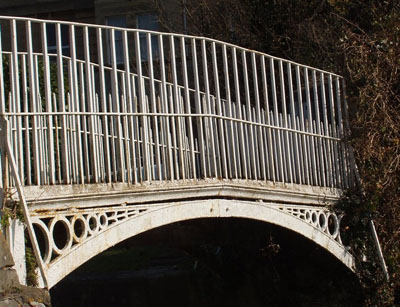 This bridge (pictured right) at first sight looked in reasonable condition, but closer inspection of this view from the east reveals that the footway is raised above the ironwork arch and the railings are embedded in it.
This bridge (pictured right) at first sight looked in reasonable condition, but closer inspection of this view from the east reveals that the footway is raised above the ironwork arch and the railings are embedded in it.
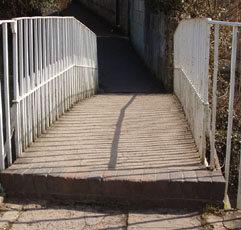 The footway consists of a more recent cement with brick facings which doesn't quite follow the contour of the top of the handrail, and the railings are rusting where they enter it. The footway also has a step to the path off it. Not shown in the picture is the uneven path leading to the new cement surface. This path appears to be original.
The footway consists of a more recent cement with brick facings which doesn't quite follow the contour of the top of the handrail, and the railings are rusting where they enter it. The footway also has a step to the path off it. Not shown in the picture is the uneven path leading to the new cement surface. This path appears to be original.
 The view from the west is similar, and in this picture on the right the cement footway is even more obvious.
The view from the west is similar, and in this picture on the right the cement footway is even more obvious.
 Under magnification the extent of the rust as the railings enter the cement is visible. It was this rust that caused some fears about the safety of pedestrians using the bridge.
Under magnification the extent of the rust as the railings enter the cement is visible. It was this rust that caused some fears about the safety of pedestrians using the bridge.
Restoration
We were told that as the investigation prior to restoration took place, it was discovered that the original footway surface beneath the cement was metal with corrugations to prevent slipping when wet. That metal surface was badly rusted, as was the cast iron supports (three of them) underneath it. The cement was both to cover the holes and to slightly strengthen the bridge. Without it the bridge would have been unusable.
 Cast iron is difficult to obtain and is not as practical as steel, so the decision was made to replace the rusted cast iron arches with steel equivalents. Each side of the arches carries a new Stothert sign, a copy of the rusted original.
Cast iron is difficult to obtain and is not as practical as steel, so the decision was made to replace the rusted cast iron arches with steel equivalents. Each side of the arches carries a new Stothert sign, a copy of the rusted original.
 The metal footway was restored as a metal footway, with non-slip inserts along it at exactly the same spacing as the original. The railings were given the minimum necessary repairs in wrought iron to match the originals, in order to maintain the appearance of age and the signs of the earlier repair work, but were rust treated and painted.
The metal footway was restored as a metal footway, with non-slip inserts along it at exactly the same spacing as the original. The railings were given the minimum necessary repairs in wrought iron to match the originals, in order to maintain the appearance of age and the signs of the earlier repair work, but were rust treated and painted.
 Also at the completion celebration was the Mayor of Bath, Cllr Chalker, who has decided that his theme for the year would be Bath's industrial heritage to complement his other role as Heritage Champion. We photographed him on the restored bridge with the Heritage Advisor of British Waterways, David Viner.
Also at the completion celebration was the Mayor of Bath, Cllr Chalker, who has decided that his theme for the year would be Bath's industrial heritage to complement his other role as Heritage Champion. We photographed him on the restored bridge with the Heritage Advisor of British Waterways, David Viner.
Wash House Bridge
The Wash House Bridge is similar in structure, being a cast iron spanning arch with wrought iron railings, but two things distinguish it: the railings are more elaborate than the Top Lock Bridge, and they were in far worse condition.
 Once again the metal footway had been covered with cement, and once again where the railings entered the cement rust had set in, only on this bridge it was so far advanced that the bottoms of the railings had rusted away in places.
Once again the metal footway had been covered with cement, and once again where the railings entered the cement rust had set in, only on this bridge it was so far advanced that the bottoms of the railings had rusted away in places.
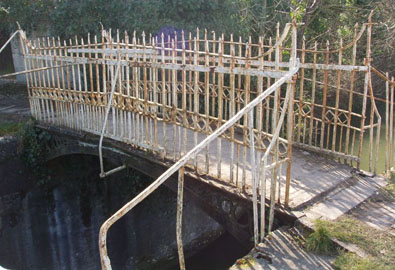 This dilapidation can be seen all over the bridge. In the view on the right there are uneven gaps between the vertical rails indicating structural weakness. With so much rusted away, there must have been a risk of the whole structure giving way if somebody leaned on it.
This dilapidation can be seen all over the bridge. In the view on the right there are uneven gaps between the vertical rails indicating structural weakness. With so much rusted away, there must have been a risk of the whole structure giving way if somebody leaned on it.
 Indeed wherever you looked on this bridge, the brown colour of rust was all pervasive. The picture on the left includes a gap where some of the decorative ironwork is missing.
Indeed wherever you looked on this bridge, the brown colour of rust was all pervasive. The picture on the left includes a gap where some of the decorative ironwork is missing.
The strap at the top of that picture is one of several temporary fixes which had been there so long that they were in a similar condition of rust. This is unattractive as a view from further away shows.
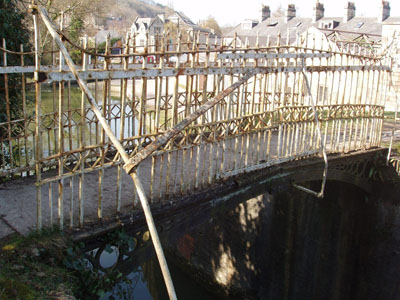 The wider view from the other side (pictured right) shows a host of emergency strapping and bracing which has been added over the years. Given that this was originally the more decorative bridge of the two, the appearance must have caused some concern about the commitment to maintaining the canal, every time someone from a narrow boat used the bridge to access the lock gates.
The wider view from the other side (pictured right) shows a host of emergency strapping and bracing which has been added over the years. Given that this was originally the more decorative bridge of the two, the appearance must have caused some concern about the commitment to maintaining the canal, every time someone from a narrow boat used the bridge to access the lock gates.
Restoration
As might be expected from the overall appearance, the restoration process revealed some horrors. We were told that as the investigation prior to restoration took place, it was discovered that the original footway surface beneath the cement was metal with corrugations to prevent slipping when wet, very similar to the Top Lock Bridge. And like its sister bridge that metal surface was badly rusted. The real horror was in the cast iron supporting arches underneath it. The cement was thinner on this bridge, so it added weight but not strength to the span, and one of the three castings it covered was cracked. The load bearing capacity of this bridge must have been well below what it should have been.
Again the aim of the restoration was to make it sound, but not to make it look new. Where necessary, new railings were created in wrought iron, but purely cosmetic improvements were avoided.
 And here is the final result. All the previous clutter of bracing bars and holding straps has disappeared, the missing railings have been replaced, the gaps where the decorative diamond shape had rusted away are inconspicuously mended. However, the slight damage to arrowheads topping the verticals has been retained.
And here is the final result. All the previous clutter of bracing bars and holding straps has disappeared, the missing railings have been replaced, the gaps where the decorative diamond shape had rusted away are inconspicuously mended. However, the slight damage to arrowheads topping the verticals has been retained.
The footway is like the Top Lock, metal with non-slip inserts supported on steel arches.
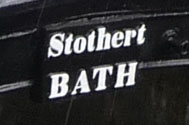
The Stothert name is restored to prominence, matching the original. Once again it is a bridge that Stotherts would have been proud of.
Pump House Chimney
 The pump house and chimney were constructed around 1830 for the purpose of pumping up to the pound above the top lock, but a dispute over water extraction rights led to pumping being discontinued and the pumps were sold in 1855. The pumping station is long gone, but the chimney has remained adorning the canal side.
The pump house and chimney were constructed around 1830 for the purpose of pumping up to the pound above the top lock, but a dispute over water extraction rights led to pumping being discontinued and the pumps were sold in 1855. The pumping station is long gone, but the chimney has remained adorning the canal side.
 The chimney is constructed of shaped Bath stone blocks anchored internally by iron bands. When the pump was in operation and the boiler fired, the heat from the fire would have preserved such a construction almost indefinitely. But without the fire, the iron straps rusted. A key feature of rusty iron is that when rust sets in it initially occupies more space than the iron alone, and then gradually the iron is replaced by rust and it crumbles. Hence the chimney first suffered structural damage from the expansion force of the rust setting in, and then suffered from weakness as the iron ties got so rusty that they no longer tied the stonework together.
The chimney is constructed of shaped Bath stone blocks anchored internally by iron bands. When the pump was in operation and the boiler fired, the heat from the fire would have preserved such a construction almost indefinitely. But without the fire, the iron straps rusted. A key feature of rusty iron is that when rust sets in it initially occupies more space than the iron alone, and then gradually the iron is replaced by rust and it crumbles. Hence the chimney first suffered structural damage from the expansion force of the rust setting in, and then suffered from weakness as the iron ties got so rusty that they no longer tied the stonework together.
The chimney had a noticeable lean before this deterioration but it had also developed an additional curve as mortar joints split, and eventually it would have fallen down. When work started, the urn shape at the top was discovered to be only resting on the rest of the chimney, because the mortar was no longer holding it.
Restoration
Restoration was therefore urgent, and planning permission was granted to dismantle it as far as the top of the base plinth (below the lower scrolls in the picture on the right). The iron bands were to be replaced by stainless steel, and the existing stone was to be reused where possible and if too badly damaged, replaced by new stone carved to the original shape.
And the result is in the picture on the right. The lighter colour of the new stone will weather in time and become less obvious. Because the base plinth was unaltered, the characteristic lean that it imparts to the rest of the chimney remains.
This was a first class restoration, which because of the use of natural stone and stainless steel should last for centuries. Well done to all concerned.
Go back to top index
Claverton Pumping Station
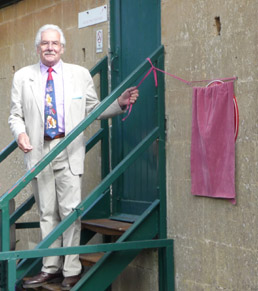 On 12 September 2012, Watchdog was invited to the Claverton Pumping Station to see the unveiling of the Red Wheel plaque, presented by The Transport Trust. The formal unveiling was done by Cllr Bryan Chalker, the council's Heritage Champion. The Red Wheel scheme is the transport heritage equivalent of the English Heritage Blue Plaque scheme which recognises buildings of particular historic interest.
On 12 September 2012, Watchdog was invited to the Claverton Pumping Station to see the unveiling of the Red Wheel plaque, presented by The Transport Trust. The formal unveiling was done by Cllr Bryan Chalker, the council's Heritage Champion. The Red Wheel scheme is the transport heritage equivalent of the English Heritage Blue Plaque scheme which recognises buildings of particular historic interest.
 A short news item has appeared on-line, but at the time of writing this, it had not appeared in print.
A short news item has appeared on-line, but at the time of writing this, it had not appeared in print.
The event was a combination of the efforts of the Canal & River Trust (formerly British Waterways), The Kennet & Avon Canal Trust who own the pumping station, the Claverton Pumping Station Volunteers and of course the Transport Trust. Watchdog's contribution was minimal, but we are known to the Transport Trust because we are working with them on their plans for the Red Wheel plaque which they wish to award to Bath Spa Station. Our thanks also go to the crew of the "Barbara McLellan" who took us and the other invited guests along the canal from the car park to the Pumping Station and back and saved us a long walk.
 The Claverton Pumping Station has been honoured because it is the only one in Britain that uses the flow of a river to power a pump which transfers water from the same river into a canal, making it particularly environmentally friendly. The Claverton Volunteers think there might be one other like it in Europe and they are trying to find out more about it, but even if that proves to be genuine, being one of two in the world does make the Claverton one rather special. It's late Georgian date probably makes it the oldest. The fact that it connects river to canal via a pipe under a railway matches well with the Transport Trust's interest in all forms of transport.
The Claverton Pumping Station has been honoured because it is the only one in Britain that uses the flow of a river to power a pump which transfers water from the same river into a canal, making it particularly environmentally friendly. The Claverton Volunteers think there might be one other like it in Europe and they are trying to find out more about it, but even if that proves to be genuine, being one of two in the world does make the Claverton one rather special. It's late Georgian date probably makes it the oldest. The fact that it connects river to canal via a pipe under a railway matches well with the Transport Trust's interest in all forms of transport.
At the time of the award the water wheel is undergoing restoration of the wooden paddles. This is the problem with an attraction that only runs occasionally (there is an electric pump maintaining the water levels in the canal nowadays). When the Pumping Station was the only source of water for the canal, it ran continuously and the wood was permanently wet, and it lasted a long time. Now that the wheel runs only intermittently, the wood gets wet in use and dries during idle times, and it deteriorates quicker under those conditions. The current restoration is expected to have a 30-year life under the modern pattern of usage. The Pumping Station Volunteers are aiming to have the restoration completed in time for the 200th anniversary of the pump's first use.
Go back to top index

